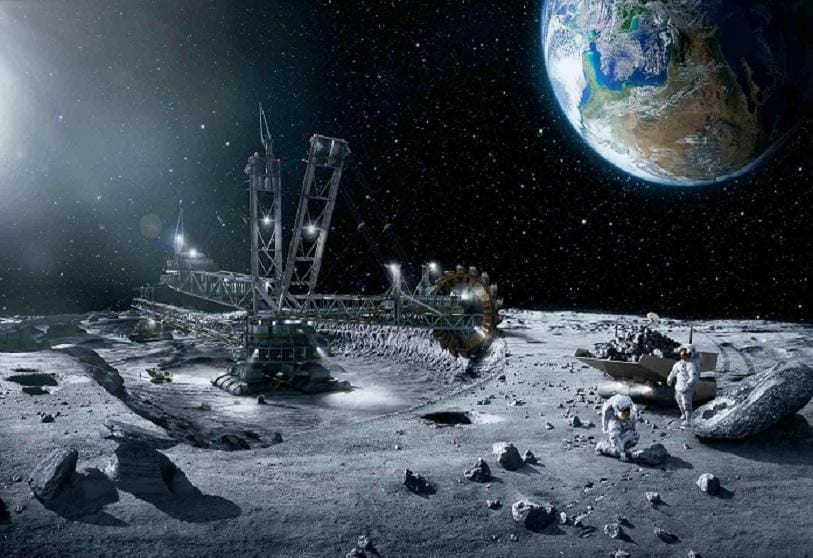Interplanetary Settlement refers to the proposed permanent settlement and exploitation of natural resources of astronomical bodies other than Earth. As such, it represents a type of human presence in space that extends beyond human spaceflight and space outpost operations.
Reasons for Human Space colonisation
Survival of human civilization:
The long-term survival of human civilization and terrestrial life is the primary reason for space colonisation. By establishing alternate sites outside of Earth, the Earth’s population, especially humans, may survive natural or man-made disasters on our own planet. Stephen Hawking, a theoretical physicist and cosmologist, has advocated for space colonisation as a method of preserving mankind on two occasions. Hawking warned in 2001 that the human race will become extinct over the next thousand years unless space colonies can be constructed. In 2010, he declared that mankind had two choices: either occupy space over the next two hundred years, or we will face the long-term prospect of extinction.

Vast resources in space:
There are immense resources in space, both in terms of minerals and energy. According to various estimates, the Solar System alone has enough energy and materials to sustain anywhere from several thousand to over a billion times the current Earth-based human population, largely from the Sun itself. Asteroid mining will also play an important role in space colonisation. Asteroids are rich in water and resources for building structures and shielding. To improve space travel, mining and fuel stations can be created on asteroids rather than on Earth.

Alleviating overpopulation and resource demand:
One reason for space colonisation is to offset the effects of global overpopulation, such as resource depletion. If the resources of space were made available for utilisation and suitable life-supporting habitats were developed, Earth’s boundaries of expansion would no longer be defined. Despite the fact that many of Earth’s resources are non-renewable, off-planet colonies might provide the bulk of the planet’s resource needs. The availability of extraterrestrial resources would reduce demand for earthly resources.
Expansion with fewer negative consequences:
Human expansion and technological advancement have typically led in some type of environmental degradation and the loss of habitats and the animals that inhabit them. In the past, expansion has frequently resulted in the displacement of numerous indigenous peoples, with the resultant treatment of these peoples ranging from encroachment to genocide. Because there is no known life in space, this does not have to be a problem, as some supporters of space settlement have pointed out.

Locations
Location is a frequent source of disagreement among advocates of space colonization. Colonization can occur on a physical body planet, dwarf planet, natural satellite, asteroid, or an orbiting one.
Mercury:
Mercury, once assumed to be a volatile-depleted world like our Moon, is now discovered to be volatile-rich, in fact, richer in volatiles than any other terrestrial body in the inner Solar System. The planet also gets six and a half times the solar flux of the Earth/Moon system, making solar energy a tremendously efficient energy source that could be harvested by orbiting solar arrays and transmitted to the surface or exported to other worlds. A Mercury colony, on the other hand, would need extensive protection from radiation and solar flares.

Venus:
The colonisation of Venus has been the topic of numerous works of science fiction, and it is currently being debated both fictionally and scientifically. However, after the discovery of Venus’s highly hostile surface climate, interest has switched mostly to the colonisation of the Moon and Mars, with suggestions for Venus focusing on dwellings floating in the upper-middle atmosphere and terraforming.
Venus has several parallels to Earth that, if not for the inhospitable environment, may make colonisation easier in many ways compared to other viable places. Venus has been dubbed Earth’s “sister planet” due to its similarities and closeness. Venus also poses numerous major hurdles to human settlement. The weather conditions on Venus are daunting: the temperature at the equator is roughly 450 °C, which is greater than the melting point of lead. The surface atmospheric pressure is also at least ninety times stronger than on Earth, which is similar to the pressure felt beneath a kilometre of water. Additionally, water in any form is virtually nonexistent on Venus. The atmosphere is mostly composed of carbon dioxide and lacks molecular oxygen. Furthermore, the visible clouds are made up of caustic sulfuric acid and sulphur dioxide vapour.

The Moon:
Because of its closeness to Earth and lower escape velocity, the Moon has been proposed as a potential settlement location. Abundant ice in some locations may supply a lunar colony’s water demands. However, the Moon’s lack of atmosphere gives no protection from space radiation or meteoroids, therefore lunar lava tubes have been considered as a solution. The Moon’s low surface gravity is also a source of worry, since it is uncertain if 1/6g is sufficient to sustain human health for lengthy periods of time. Interest in creating a moon base as a gateway to Mars colonisation has grown in the twenty-first century, with concepts such as the Moon Village for research, mining, and trading facilities with permanent inhabitants.

Mars:
Mars colonisation has piqued the curiosity of both governmental and corporate space organisations, and has received significant theoretical portrayal in science fiction literature, cinema, and artwork. Organizations have suggested proposals for a human expedition to Mars, the first stage in any colonisation endeavour, but no one has stepped foot on the planet, and no return journeys have been completed. Landers and rovers, on the other hand, have successfully investigated the planetary surface and given data regarding ground conditions. Interest, the ability for people to offer more in-depth observational studies than unmanned rovers, commercial interest in its resources, and the prospect that the settlement of other planets might reduce the chance of human extinction are all reasons for populating Mars. Difficulties and risks include radiation exposure during the travel to Mars and on its surface, poisonous soil, reduced gravity, the loneliness that comes with Mars’ distance from Earth, a lack of water, and freezing temperatures.

Asteroid belt:
The asteroid belt has a large amount of material accessible, but it is thinly scattered since it covers such a large area of space. Ceres is the biggest asteroid, with a diameter of around 940 kilometres, large enough to be considered a dwarf planet. Pallas and Vesta, both around 520 kilometres in diameter, are the next two biggest. Unpiloted supply spacecraft should be able to reach 500 million kilometres of space with no technical advancement.
Ceres possesses easily available water, ammonia, and methane, which are critical for Mars and Venus’ survival, fuel, and even terraforming. The colony might be developed either on the surface or beneath. However, even Ceres has a minuscule surface gravity of 0.03g, which is insufficient to offset the deleterious consequences of microgravity while making transit to and from Ceres simpler. As a result, either medical treatments or artificial gravity would be necessary. Furthermore, colonising the main asteroid belt would very certainly necessitate the presence of infrastructure on the Moon and Mars.

What is the ideal place for humans?
Mars appears to be our greatest bet for long-term interplanetary colonisation. It has one-third the gravity of Earth, it takes just five to six months to travel there with present technology, and it has vast amounts of ice that might be transformed into liquid water. Solar panels can be easily placed on the planet’s surface as an energy source, and Elon Musk has a not-so-crazy proposal to create fuel on the planet using atmospheric methane.
Although the red planet is not as awful as other locations, it is still a freezing, barren, lifeless wasteland. Certain creatures will not be harmed by this, but humans will still need to construct pressurised dwellings capable of bringing temperatures to a reasonable range and life support systems capable of providing food, water, and oxygenated air as required. There’s also the issue of the planet’s surface being exposed to high levels of UV light and solar radiation in the absence of a substantial atmosphere or magnetic field. And if a solar storm were to strike the planet, it would destroy virtually all critical electronic equipment on the ground and in space.

Works Cited
Building a Marsbase is a Horrible Idea: Let’s do it! Perf. Steve Taylor. Kurzgesagt. 2019. Web. 14 May 2022. <https://www.youtube.com/watch?v=uqKGREZs6-w&list=PL_tf9drfAM_1XOzbklaJMC9Y4KBLwSGXM&index=2>.
Colonization of Mars. 9 May 2022. Web. 14 May 2022. <https://en.wikipedia.org/wiki/Colonization_of_Mars>.
Colonization of the Moon. 8 May 2022. Web. 14 May 2022. <https://en.wikipedia.org/wiki/Colonization_of_the_Moon>.
Colonization of Venus. 28 March 2022. Web. 14 May 2022. <https://en.wikipedia.org/wiki/Colonization_of_Venus>.
How To Terraform Venus (Quickly). Perf. Steve Taylor. Kurzgesagt. 2021. Web. 14 May 2022. <https://www.youtube.com/watch?v=G-WO-z-QuWI&list=PL_tf9drfAM_1XOzbklaJMC9Y4KBLwSGXM&index=6>.
How We Could Build a Moon Base TODAY – Space Colonization 1. Perf. Steve Taylor. Kurzgesagt. 2019. Web. 14 May 2022. <https://www.youtube.com/watch?v=NtQkz0aRDe8&list=PL_tf9drfAM_1XOzbklaJMC9Y4KBLwSGXM&index=1>.
Patel, Neel V. THE BEST EXTRATERRESTRIAL WORLDS TO COLONIZE IN THE SOLAR SYSTEM. 5 September 2017. Web. 14 May 2022. <https://www.inverse.com/article/30832-6-best-extraterrestrial-worlds-colonize-solar-system>.
Space colonization. 27 April 2022. web. 14 May 2022. <https://en.wikipedia.org/wiki/Space_colonization#Vast_resources_in_space>.
Unlimited Resources From Space – Asteroid Mining. Perf. Steve Taylor. Kurzgesagt. 2021. Web. 14 May 2022. <https://www.youtube.com/watch?v=y8XvQNt26KI&list=PL_tf9drfAM_1XOzbklaJMC9Y4KBLwSGXM&index=4>.
What If Humanity Became an Interstellar Species? What If. 2018. Web. 14 May 2022. <https://www.youtube.com/watch?v=8VzSqYooxmw>.



